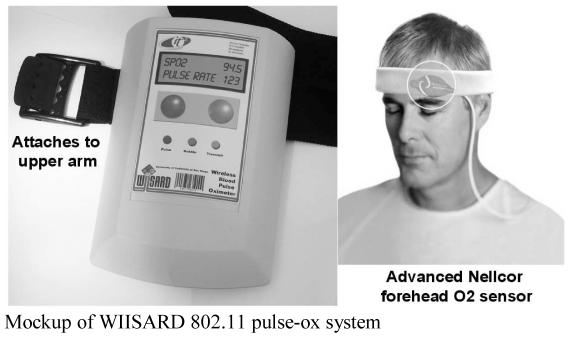Abstract
In a mass casualty situation, medical personnel at the disaster site and other field treatment settings may need to monitor the vital signs of hundreds of seriously injured patients with minimal staffing. The conditions may be primitive and personnel may have to improvise infrastructure. As part of our research to enhance medical response to disasters with Internet-enabled systems, we have developed a prototype Wireless Blood Pulse Oximeter system for mass casualty events designed to operate in WiFi hotspots. Pulse ox units were designed using low-cost embedded system technologies to operate in integrated or stand alone environments. Units can report data to a command post on the scene or any remote location with Internet access. The entire system is potentially capable of tracking and monitoring several hundred patients.
In a mass casualty setting, the number of victims may overwhelm the available transport resources (or the disaster may destroy transport networks) creating the requirement to improvise field hospitals for care. Large-scale disasters may overwhelm available emergency room resources, or damage hospitals, resulting in the need to set up treatment areas in ad hoc locations such as parking lots. If there are many thousands of victims, any standing structure might become a refuge, particularly if it has backup power supplies. An indoor shopping mall, a university library, or a home could become a mass casualty collection and treatment center.
In these improvised emergency centers, scores to hundreds of patients might require the equivalent of critical care in primitive conditions. Vital signs monitoring of the critically injured victims could dramatically enhance the effectiveness of limited medical resources in such settings; however, patient telemetry would need to be able to use existing or readily available infrastructure for data communications.
The Wireless Internet Information System for Medical Response to Disasters (WIISARD) project is a National Library of Medicine funded project researching the development of new Internet technologies to enhance care in mass casualty settings. As part of this project we are conducting research to develop low-cost 802.11-based solutions for vital signs telemetry during mass casualty situations. Our goal is to allow responders to use the WiFi bubble surrounding a coffee house or a home to support an improvised aid station/hospitals.
The WIISARD pulse oximeter system is based on use of an embedded-systems 802.11 technology. The core of the unit is the DPAC Airborne module (Irvine, CA). Features of the Airborne module include a highly integrated 802.11b wireless module with radio, baseband and application processor, a built-in web server application, integrated RTOS and TCP/IP Stack, and configurable serial, digital and analog I/O ports in a small, rugged package and designed for high/low temperature operation. The DPAC unit is powered by a Ubicom processor that supports programming of applications in the C language. The DPAC module is mated to a Nellcor MP100 pulse oximeter sensor controller (Pleasanton, CA). This controller unit is capable of utilizing a novel forehead sensor developed by Nellcor, which may have superior ergonomics and performance for field operations. The pulse oximeter is packaged in a waterproof and rugged enclosure (IP65), with displays/sounds for alert conditions. Estimated battery life is 9 hours. Estimated cost of parts is $360 dollars. The pulse oximeter can work collaboratively with the WIISARD environment using web services or with a stand-alone Windows XP application called WizMon that supports monitoring of hundreds of victims on an ordinary laptop computer. The WIISARD pulse oximeter system is currently under rapid development with prototypes due for fabrication and assembly in June 2005 for deployment in a mass casualty drill in November 2005. “Breadboard” versions of the unit have been completed and are undergoing testing.
Mockup of WIISARD 802.11 pulse-ox system
Acknowledgments
This work is supported by contract N01-LM-3-3511 from the National Library of Medicine.



